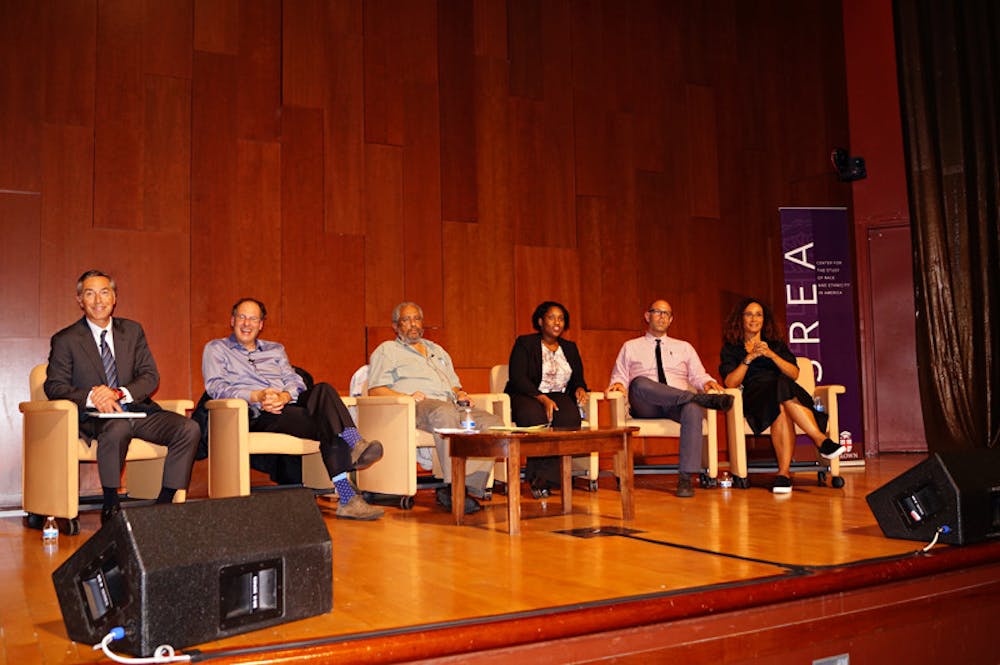Hundreds of snaps rang throughout Salomon 101 in support of speakers’ messages of directly confronting racial tensions during a teach-in Tuesday about the events surrounding last month’s fatal shooting of unarmed black teenager Michael Brown by a white policeman in Ferguson, Missouri.
The teach-in was a way of “stimulating an honest conversation,” said Richard Locke, director of the Watson Institute for International Studies, who moderated the panel.
James Morone, director of the Taubman Center for Public Policy, began the discussion by assessing the social anxiety brought on by changing demographics in the United States.
“Great change brings great anxieties, great status anxieties, for an awful lot of people,” he said, citing some whites’ concerns related to the rising non-white share of the U.S. population.
“What we’re seeing in Ferguson, Missouri is the United States looking in the mirror and confronting this great change,” Morone said. But he added that he thinks the future is “optimistic” and that dialogue about racial tension will ultimately lead to positive change.
Anthony Bogues, director of the Center for the Study of Slavery and Justice, said the events in Ferguson — which include a sustained series of violent and nonviolent protests of the police action — “represent a flashpoint” illuminating “things that are typically hidden.”
“Flashpoints are about everyday experience,” he said, referring to daily social constraints faced by blacks. “Ask a mother who cannot sleep until her black son comes home safely.”
Marcia Chatelain MA’03 PhD’08, assistant professor of history at Georgetown University, addressed social media’s role in the controversy. She started the hashtag, “FergusonSyllabus” on Twitter, which she said has motivated many teachers to include a conversation about the Ferguson events in their classrooms.
“When you’re a teacher, sometimes it’s very isolating,” Chatelain said. But racial conflict linked to Ferguson is an “opportunity to have a conversation across disciplines.”
Chatelain said she included discussions about Ferguson in both her history and food culture classes.
Stefano Bloch, a postdoctoral fellow in urban studies, said the militarized equipment and dress of police officers contributes to violence.
“Fashion and style do in fact matter, and have dire consequences for peace and justice,” Bloch said. “Simply having officers dressed in everyday uniforms” may lead to more peaceful encounters, Bloch later said in response to an audience question.
“The public framing of what happened has turned into a very microscopic view of the event,” said Tricia Rose, director of the Center for the Study of Race and Ethnicity in America. She criticized the way the media has focused on “individual circumstances” of the case rather than the larger social context.
While open racial discrimination is no longer legal in the United States, the country is still plagued by more subtle forms of racism, Rose said.
“We have no more racists, but we have enormous amounts of structural racism,” Rose said as she advocated for “anti-racist education.”
The question-and-answer session following the panel featured so many queries from audience members that a large number were turned away due to time constraints.
Audience members started a “FergusonTeachIn” hashtag on Twitter during the dialogue that featured compelling quotes from speakers and commentary on the exchange.
Responding to a question about how attendees could learn more about the dialogue, Rose cited classes in the Department of Africana Studies, the Department of Ethnic Studies and elsewhere that are available to students seeking to deepen their understanding of such issues.
Anne Prusky ’18 said she attended the discussion to “involve” and “educate” herself, adding that the teach-in met her expectations. “I expected to feel very slightly uncomfortable, in a growth-is-happening kind of way,” she said.
“I definitely think that this is a great starting point,” said Maya Finoh ’17. But she said she would like to see a teach-in on structural racism in the future.
Throughout the semester, Locke said students can look forward to other events being planned with the intention of increasing literacy on racially charged issues.

ADVERTISEMENT




